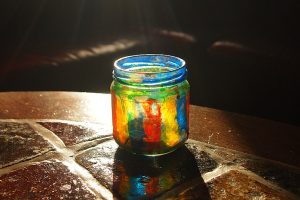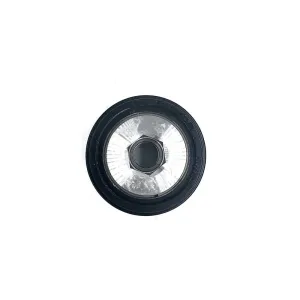Reactive dyes are also known asReactive dyesIt is a new class of water-soluble dyes that appeared in the 50s of the 20th century, and the reactive dye molecule contains hydroxyl groups that can be combined with celluloseProtein fiberThe active group that reacts with the amino group in the middle of the amino group forms a covalent bond with the fiber when dyed, forming a “dye-fiber” compound. Reactive dyes have the characteristics of bright color, good uniformity, simple dyeing method, high dyeing fastness, complete chromatography and low cost, and are mainly used in dyeing and printing of cotton, linen, viscose, silk, wool and other fibers and their blended fabrics.

definition #
Reactive dyes are also called reactive dyes. The molecule contains chemically reactive onesGroup, can beaqueous solutionIt is a dye that reacts with cotton, wool and other fibers to form a common bond. It has a high washing resistanceFastness
classify #
According to the different active groups, reactive dyes can be divided into two main categories. Symmetrical triazine type Its general formula is:
where D is the parent dye. In this class of reactive dyes, the active base chlorine atomChemical propertiesMore lively. When stained, chlorine atoms are detected in an alkaline mediumCellulose fiberReplace, become goneGroupLeave. The reaction between the dye and the cellulose fibers belongsBimolecular nucleophilic substitution reaction。
Ethylene sulfoneThe active group contained in this type of reactive dye is ethyleneSulfone base(D-SO2CH=CH2) orβ- Hydroxyethyl sulfonyl sulfate. When dyeing,β-Hydroxyethyl sulfate in an alkaline mediumEliminate reactionsEthylene sulfone groups are generated, which are then combined with cellulose fibers and transnucleophilicAddition reactionformationcovalent bond。
These two types of reactive dyes are the most produced major reactive dyes in the world. In order to improve the reactivity of the dyesColor fixation, in recent years, two activities have been introduced into the dye moleculeGroup, called a double reactive dye. Reactive dyes are removedCellulose fiberIn addition to the varieties used, it has also been developedProtein fiber。
craft #
dyeing methods for reactive dyes; Reactive dyes dyeing cotton, the most commonly used dyeing methods:Dip dyeing methodand in additionPaddyeingMaterial. Dipping method: Dipping method can be divided into three dyeing methods: one-bath one-step method, one-bath two-step method, and two-bath method. A: One bath one-step method: it is dyeing in an alkaline bath, that is, fixing the color while dyeing, this method has a simple process, short dyeing time, and convenient operation, but because the adsorption and color fixation are carried out at the same time, the dye can no longer diffuse after fixing, so the leveling and transmittance are poor. Tongjin dyeing under alkaline conditions, the dye stability of the dye bath, and the hydrolysis is more. B: One-bath two-step method: first dyed in a neutral bath as a dyeDyeingWhen close to equilibrium, add in a dye bathAlkaline agents, adjust the PH value to the specified PH value of color fixation, (generally 11) at this time, the dye and the fiber achieve covalent binding to achieve the purpose of color fixing. The one-bath two-step method is a more reasonable dyeing method in the reactive dye dipping method, which can not only obtain a higher levelDyeing rateandColor fixation。 Moreover, it has a good leveling effect, so this method is commonly used for dyeing cotton knitted fabrics.
merit #
Reactive dyes are composed of parent dyes, binding groups and active groups, so that they can form a strong bond with fibers when usedcovalent bondcombined, and with a range of othersCellulose fiberThe incomparable characteristics of dyes have established their position as the focus of the development and use of dyes for cellulose fibers, which are prominently reflected in the following four aspects:
(1) Reactive dyes are used to replace prohibited dyes and other types of cellulose such as dyesSulfur dyes、Ice dyeandVat dyesOne of the best options for so on.
(2) Reactive dyes can obtain a high level of firmness with economical dyeing process and simple dyeing operation, especially wetFastness。
(3) Reactive dyes have a wide chromatograph, bright color, excellent performance and strong applicability, and their hue and performance are basically compatible with the requirements of the market for fibers and clothing.
(4) Reactive dyes are suitable for new modelsCellulose fiberProducts such as:Lyocell fibersand other printing and dyeing needs.
shortcoming #
However, the main technical problems of reactive dyes are as follows:
(1) The utilization rate is not high enough, generally 60%~70%, producing a large amount of colored sewage, its color is more than thousands of times, and the COD value is generally 08,000~30,000ppm, which is concentratedwastewaterThe COD value should be more than 50,000 ppm.
(2) In order to suppress the charge on the fiber surface, a considerable amount of electrolyte needs to be consumed when the reactive dye is used, which not only increases the labor intensity, but also causes the waste waterChloride ionsThe concentration is as high as more than 100,000 ppm, which greatly increases the difficulty of treating reactive dye dyeing wastewater.
(3) SomeColour fastnessUnable to meet market requirements, such as sweat fastness to sunlight, wetRubbing fastnessandAzoThe light fastness of red dyes and azo blue dyes in light colors.
(4) It can replace sulfide and vulcanized materialsVat dyesThere are fewer dark-colored varieties such as others.
Functional use #
Reactive dyes are composed of parent dyes, binding groups and active groups, so that they can form strong covalent bonds with fibers when used, and have a series of characteristics that other cellulose fiber dyes cannot match, which has established its position as the focus of the development and use of dyes for cellulose fibers, which is prominently manifested in the following four aspects:
(1) Reactive dyes are used to replace prohibited dyes and other types of cellulose such as dyesSulfur dyes、Ice dyeandVat dyesOne of the best options for so on.
(2) Reactive dyes can obtain a high level of firmness with economical dyeing process and simple dyeing operation, especially wetFastness。
(3) Reactive dyes have a wide chromatograph, bright color, excellent performance and strong applicability, and their hue and performance are basically compatible with the requirements of the market for fibers and clothing.
(4) Reactive dyes are suitable for the printing and dyeing of new cellulose fiber products, such as Lyocell fiber.
Main technology #
here are four points:
(1) The utilization rate is not high enough, generally 60%~70%, producing a large amount of colored sewage, its color is more than thousands of times, and the COD value is generally 08,000~30,000ppm, which is concentratedwastewaterThe COD value should be more than 50,000 ppm.
(2) In order to suppress the charge on the fiber surface, a considerable amount of electrolyte needs to be consumed when the reactive dye is used, which not only increases the labor intensity, but also causes the waste waterChloride ionsThe concentration is as high as more than 100,000 ppm, which greatly increases the difficulty of treating reactive dye dyeing wastewater.
(3) SomeColour fastnessUnable to meet market requirements, such as sweat fastness to sunlight, wetRubbing fastnessandAzoThe light fastness of red dyes and azo blue dyes in light colors.
(4) There are few dark-colored varieties that can replace sulfide sulfides and vat dyes.
The most effective way is to introduce two different or alloactive active groups into the reactive dye molecule, especially the former, that is, the introduction of two active groups – chlorine uniformityTriazineKi andEthylene sulfoneBase. For those composed of these two xenoactive groups and a suitable parent dye with a binding groupNew reactive dyesIn addition to having the characteristics of each component active group such as low acidityhydrolysisrate, high acidic hydrolysis bond breaking stability, excellent washability, good itemsFastnessIn addition to the smaller difference between the adsorption rate and the fixation rate, it also has new properties resulting from the addition and cross-crossing between two different active groups, such as better resistance to acid hydrolysis and peroxide washing, higher fixation rate, wider dyeing temperature range, better staining reproducibility, and suitability for medium-temperature staining,Low-temperature staining, short-time dyeing, high RFT dyeing, etc., so the output of this kind of reactive dyes has accounted for two-thirds of all reactive dyes for dyeing, and has become cotton fabricsPaddyeingwith impregnated dyes for the body.
Precautions #
The following points need to be paid attention to in the use of dyes:
1. The selection of the basic three primary colors is important, and their solubility, directness, diffusion, compatibility, susceptibility under normal fluctuations in dyeing conditions, fixation action and washable dyeability, etc., should be fully considered to ensure that the balance between the directness and diffusion of the dye can be reached quickly, and the directness, diffusion, fixation behavior and washability of the dye can be reasonably balanced.
2. When dyeing light medium color, especially light color, due toAzoSun exposure of red dyes and azo blue dyesFastnessPoor, can not meet the market demand, need to be careful choice. As for the use of sun fastness enhancers, it is necessary to pass experiments, and it is generally said to be usedUltraviolet absorbersThe method to improve the sun fastness of reactive dyes has no obvious effect.
3. When dyeing dark and thick color, many varieties are wetRubbing fastnessPoor, can not meet the market requirements, need to be used carefully. The key to improving the wet fastness to reactive dyes lies in the basic dyeability of the cotton material, namely:Cotton fiberYesSurface structure, surface structure, smoothness, coarse hardness, etc., which are directly related to the quality of raw cotton and cotton yarn and the pretreatment of cotton fiber.
4. For those proposed on the markettextilesThe requirements of composite fastness such as sweat fastness to sunlight and alkaline wet sunlight fadeColour fastnessThere are still certain problems in this kind of reactive dyes, which need to be selected through experiments, and these problems are also the focus of the research and development of dyes containing xenogeneous double reactive groups.
Acid dyes #
Acid dyes have the characteristics of complete chromatography and bright color, which are mainly used for dyeing and printing of protein fibers and polyamide fibers such as wool and silk, and can also be used for the coloring of leather, paper, cosmetics and inks, and a few are also used to make food coloring and lake pigments. Since acid dyes have very low directness to cellulose fibers, acid dyes are generally not used to dye cellulose fibers.
Structural features #
Acid dyes are mostly aromatic sulfonate sodium salts in structure, and azo and anthraquinone account for a large proportion of their chromosome structure, in addition to triarylmethane, acrazine, mouth ocanthine, indigo, quinoline, phthalocyanine and nitroimide and other chromosomes. Among the various structures, azo acid dyes occupy the first place in variety and yield, especially monoazo and diazo are the most, including yellow, orange, red, navy blue and black varieties. Anthraquinone has good sun fastness, and the color is also bright, mainly some purple, blue and green dyes, especially blue, and some anthraquinone structure acid dyes can play a brightening role in the dyeing of acid medium dyes. Triaromatic methanes are mainly red, purple, blue and green, and generally have poor sun fastness, and some bright blue varieties are not resistant to oxygen bleaching, but the color is very strong and the wet treatment fastness is better. The color and application performance of oxanthracene acid dyes are similar to those of triaryl methanes, which are generally not used alone, and are mainly used for color matching and brightening of acid mordant dyes.

 April 1, 2024
April 1, 2024 










